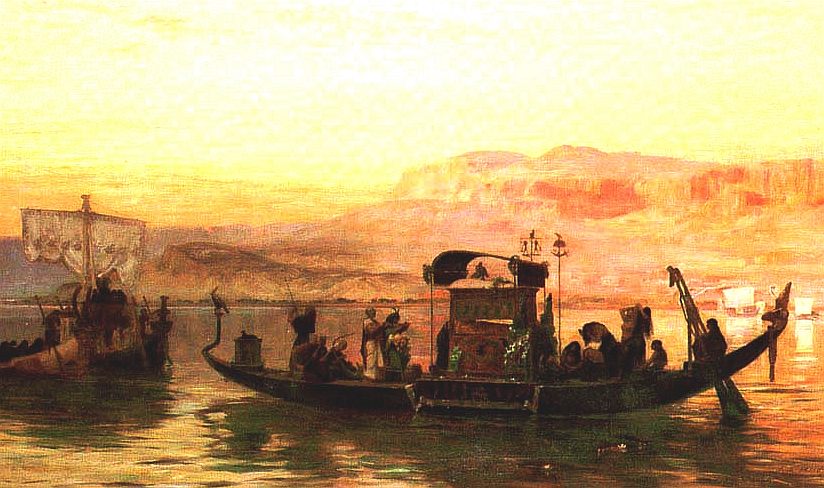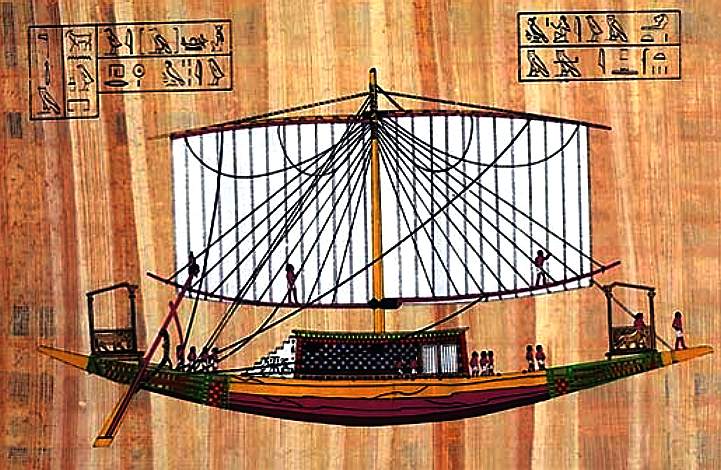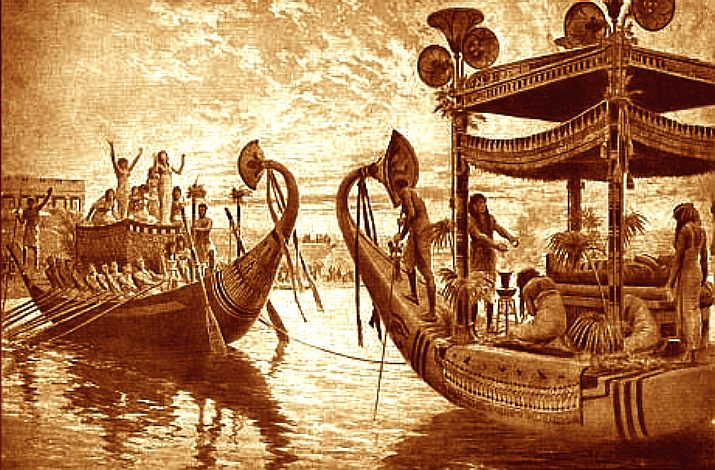|

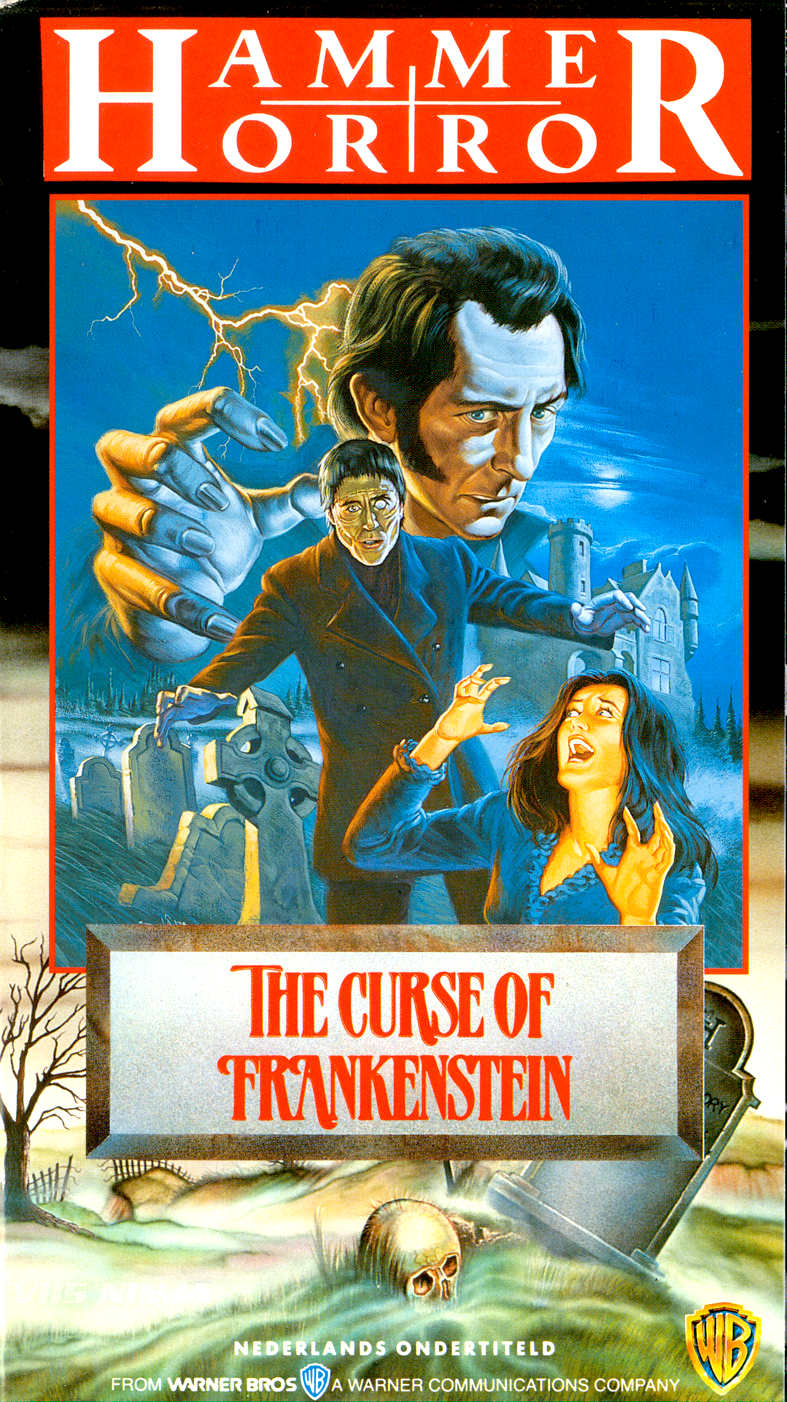
BRIDE
OF FRANKENSTEIN - Directed, like its 1931 predecessor, by Whale, this tragicomic sequel takes up where the first film left off, but surpasses it in weirdness. Karloff’s creature is more poignant than ever as he learns to speak and tries to make friends, but only succeeds in wreaking havoc. Ernest Thesiger joins the cast as Doctor Pretorius, camp as a row of tents with his collection of miniature people, who talks the baron into building a girlfriend for his lonely monster. Elsa Lanchester plays the shock-headed mate, as well as appearing as Shelley in the film’s literary prologue. Those eyes! Those teeth! What a woman.
THE BRIDE OF FRANKENSTEIN 1935
Bride of Frankenstein is a 1935 American science fiction horror film, and the first sequel to
Universal
Pictures' 1931 film Frankenstein. As with the first film, Bride of Frankenstein was directed by James Whale and stars Boris Karloff as the Monster. The sequel features Elsa Lanchester in the dual role of Mary Shelley and the titular character at the end of the film. Colin Clive reprises his role as Henry Frankenstein, and Ernest Thesiger plays the role of Doctor Septimus Pretorius.
Taking place immediately after the events of the earlier film, it is rooted in a subplot of the original Mary Shelley novel, Frankenstein; or, The Modern Prometheus (1818). Its plot follows a chastened Henry Frankenstein as he attempts to abandon his plans to create life, only to be tempted and finally coerced by his old mentor Dr. Pretorius, along with threats from the Monster, into constructing a mate for the Monster.
The preparation to film the sequel began shortly after the premiere of the first film, but script problems delayed the project. Principal photography began in January 1935, with creative personnel from the original returning in front of and behind the camera. Bride of Frankenstein was released to critical and popular acclaim, although it encountered difficulties with some state and national censorship boards. Since its release the film's reputation has grown, and it is now frequently considered one of the greatest sequels ever made; many fans and critics consider it to be an improvement on the original, and it has been hailed as Whale's masterpiece. In 1998, it was selected by the Library of Congress for preservation in the United States National Film Registry, having been deemed "culturally, historically or aesthetically significant".
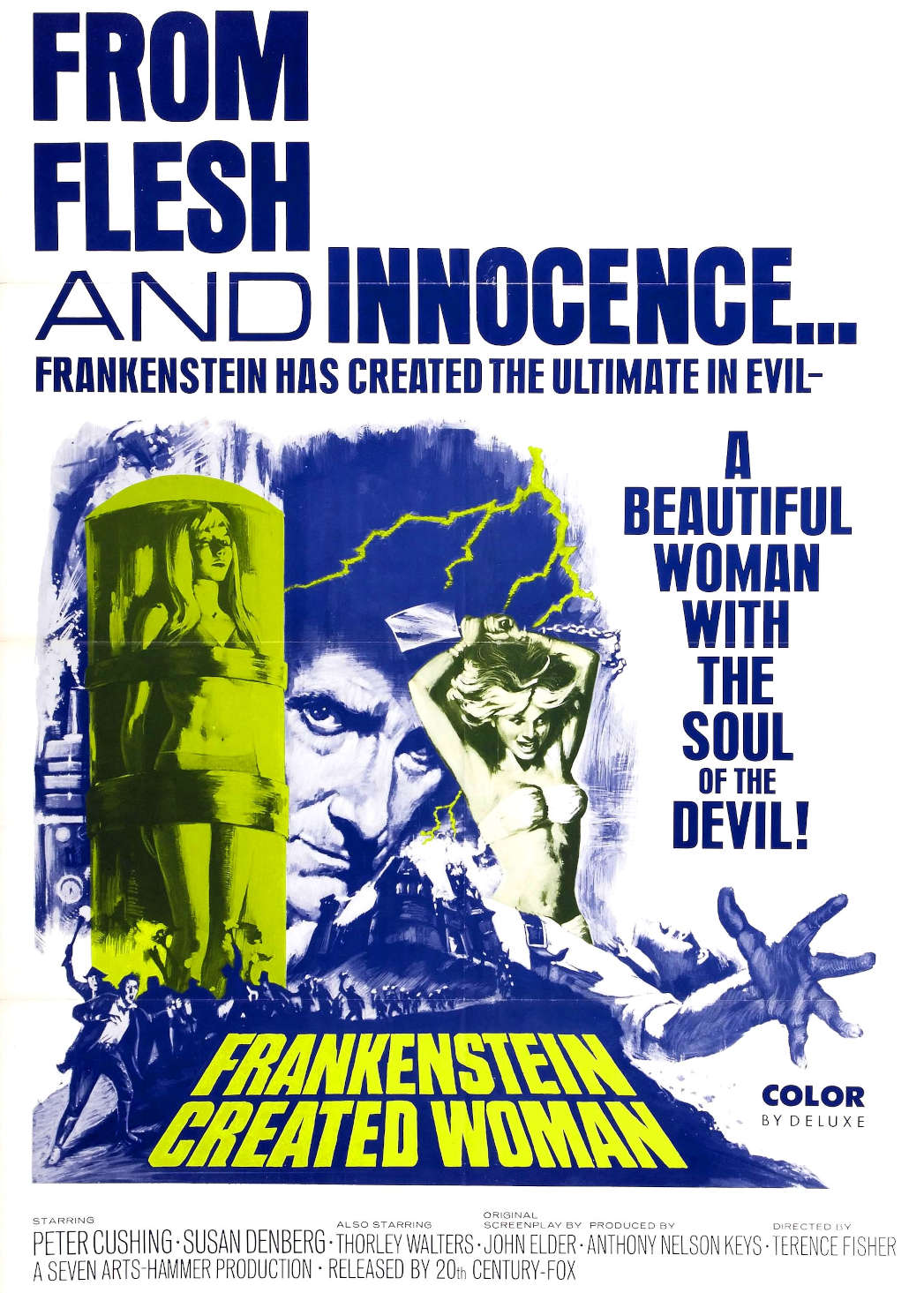
PLOT
On a stormy night, Percy Bysshe Shelley and Lord Byron praise Mary Shelley for her story of Frankenstein and his Monster. She reminds them that her intention for writing the novel was to impart a moral lesson, the consequences of a mortal man who tries to play God. Mary says she has more of the story to tell. The scene shifts to the end of the 1931 Frankenstein, in 1899.
Villagers gathered around the burning windmill cheer the apparent death of the Monster. Hans, the father of the girl the creature drowned in the previous film, wants to see the Monster's bones. He falls into a flooded pit underneath the mill, where the
Monster - having survived the fire - strangles him. Hauling himself from the pit, the Monster casts Hans' wife to her death. He next encounters Minnie, who flees in terror.
The body of Henry Frankenstein, who is thought to have died at the windmill, is returned to his fiancée Elizabeth at his ancestral castle home. Minnie arrives to sound the alarm about the Monster, but her warning goes unheeded. Elizabeth, seeing Henry move, realizes he is still alive. Nursed back to health by Elizabeth, Henry has renounced his creation, but still believes he may be destined to unlock the secret of life and immortality. A hysterical Elizabeth cries that she foresees death.
Henry visits the lab of his former mentor Doctor Septimus Pretorius, where Pretorius shows Henry several homunculi he has created. Pretorius wishes to work with Henry to create a mate for the Monster, with the proposed venture involving Pretorius growing an artificial brain while Henry gathers parts for the mate.
The Monster saves a young shepherdess from drowning. Her screams upon seeing him alert two hunters, who shoot and injure the Monster. The hunters raise a mob that sets out in pursuit. Captured and trussed to a pole, the Monster is hauled to a dungeon and chained. Left alone, he breaks his chains, overpowers the guards, and escapes into the woods.
That night, following the sound of a violin playing "Ave Maria", the Monster encounters an old blind hermit who thanks God for sending him a friend. He teaches the monster words like "friend" and "good" and shares a meal with him. Two lost hunters stumble upon the cottage and recognize the Monster. He attacks them and accidentally burns down the cottage as the hunters lead the hermit away.
Taking refuge from another angry mob in a crypt, the Monster spies Pretorius and his cronies Karl and Ludwig breaking open a grave. The henchmen depart as Pretorius stays to enjoy a light supper. The Monster approaches Pretorius and learns that Pretorius plans to create a mate for him.
Henry and Elizabeth, now married, are visited by Pretorius. When Henry expresses his refusal to assist with Pretorius' plans, Pretorius calls in the Monster, who demands Henry's help. Henry again refuses, and Pretorius orders the Monster out, secretly signaling him to kidnap Elizabeth. Pretorius guarantees her safe return upon Henry's participation. Henry returns to his tower laboratory where, despite himself, he grows excited over his work. After being assured of Elizabeth's safety, Henry completes the Bride's body.
A storm rages as final preparations are made to bring the Bride to life. Her bandage-wrapped body is raised through the roof, where electricity is harnessed from lightning to animate her. Henry and Pretorius lower her and, after realizing their success in bringing her to life, remove her bandages and help her to stand.
The Monster comes down the steps after killing Karl on the rooftop and sees his mate. The excited Monster reaches out to her and asks: "Friend?" The Bride, screaming, rejects him. The dejected Monster observes: "She hate me! Like others." As Elizabeth races to Henry's side, the Monster rampages through the laboratory. When Pretorius warns that the Monster's actions are about to destroy them all, the Monster pauses and tells Henry and Elizabeth: "Go! You live! Go!" To Pretorius and the Bride, he says: "You stay. We belong dead." While Henry and Elizabeth flee, the Monster looks at the Bride, sheds a tear, and pulls a lever to trigger the laboratory and tower's destruction.
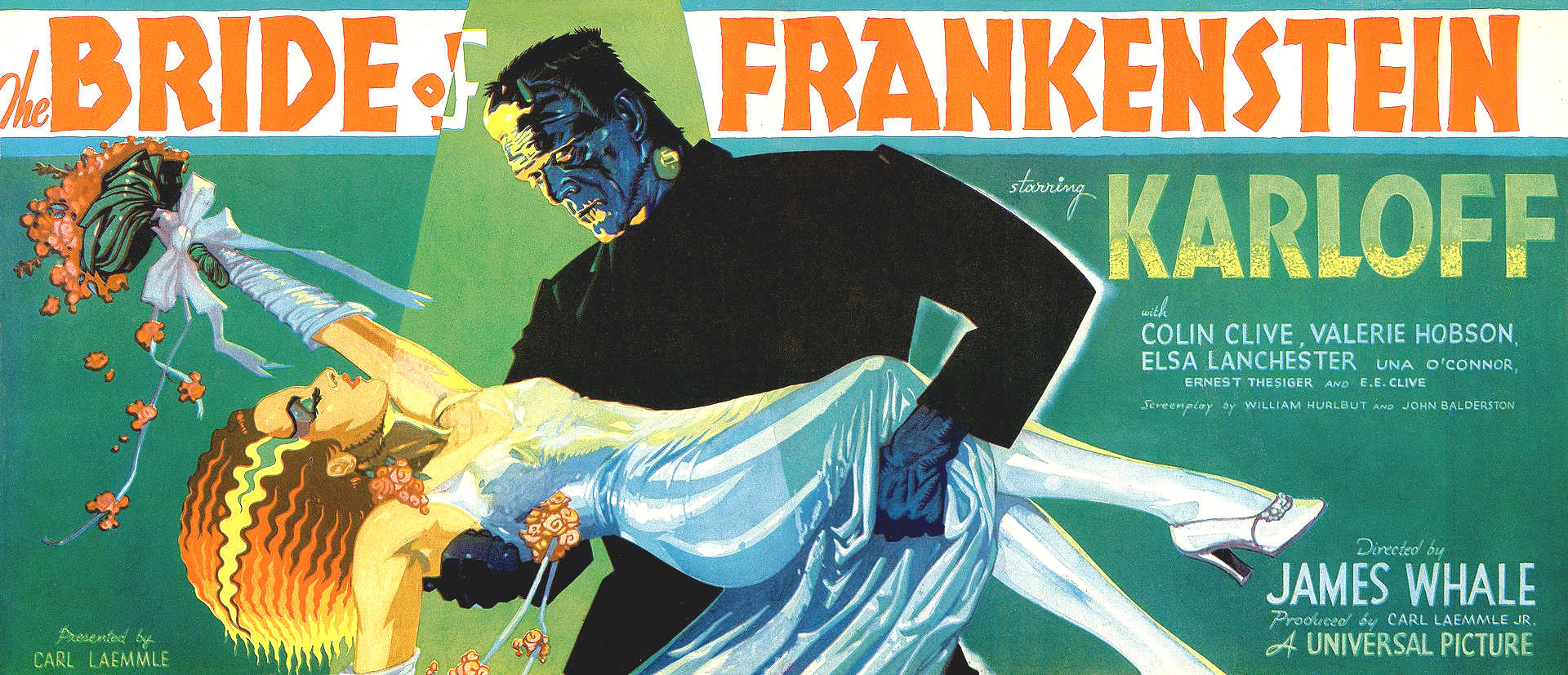
BOX OFFICE
Bride of Frankenstein was profitable for Universal, with a 1943 report showing that the film had by then earned approximately $2 million ($29.9 million in 2022 money) for the studio, a profit of about $950,000 ($14.2 million as of 2022).
CENSORSHIP
Bride of Frankenstein was subjected to censorship, both during production by the Hays office and following its release by local and national censorship boards. Joseph Breen, lead censor for the Hays office, objected to lines of dialogue in the originally submitted script in which Henry Frankenstein and his work were compared to that of God. He continued to object to such dialogue in revised scripts, and to a planned shot of the Monster rushing through a graveyard to a figure of a crucified Jesus and attempting to rescue the figure from the cross. Breen also objected to the number of murders, both seen and implied by the script and strongly advised Whale to reduce the number. The censor's office, upon reviewing the film in March 1935, required a number of cuts. Whale agreed to delete a sequence in which Dwight Frye's "Nephew Glutz" kills his uncle and blames the Monster, and shots of Elsa Lanchester as Mary Shelley in which Breen felt too much of her breasts were visible. Curiously, despite his earlier objection, Breen offered no objection to the cruciform imagery throughout the film – including a scene with the Monster lashed Christ-like to a pole – nor to the presentation of Pretorius as a coded homosexual. Bride of Frankenstein was approved by the Production Code office on April 15, 1935.
Following its release with the Code seal of approval, the film was challenged by the censorship board in the state of Ohio. Censors in England and China objected to the scene in which the Monster gazes longingly upon the body intended for reanimation as the Bride, citing concerns that it looked like necrophilia. Universal voluntarily withdrew the film from Sweden because of the extensive cuts demanded, and Bride was rejected outright by Trinidad, Palestine, and Hungary. Additionally, Japanese censors objected to the scene in which Pretorius chases his miniature Henry VIII with tweezers, asserting that it constituted "making a fool out of a king".
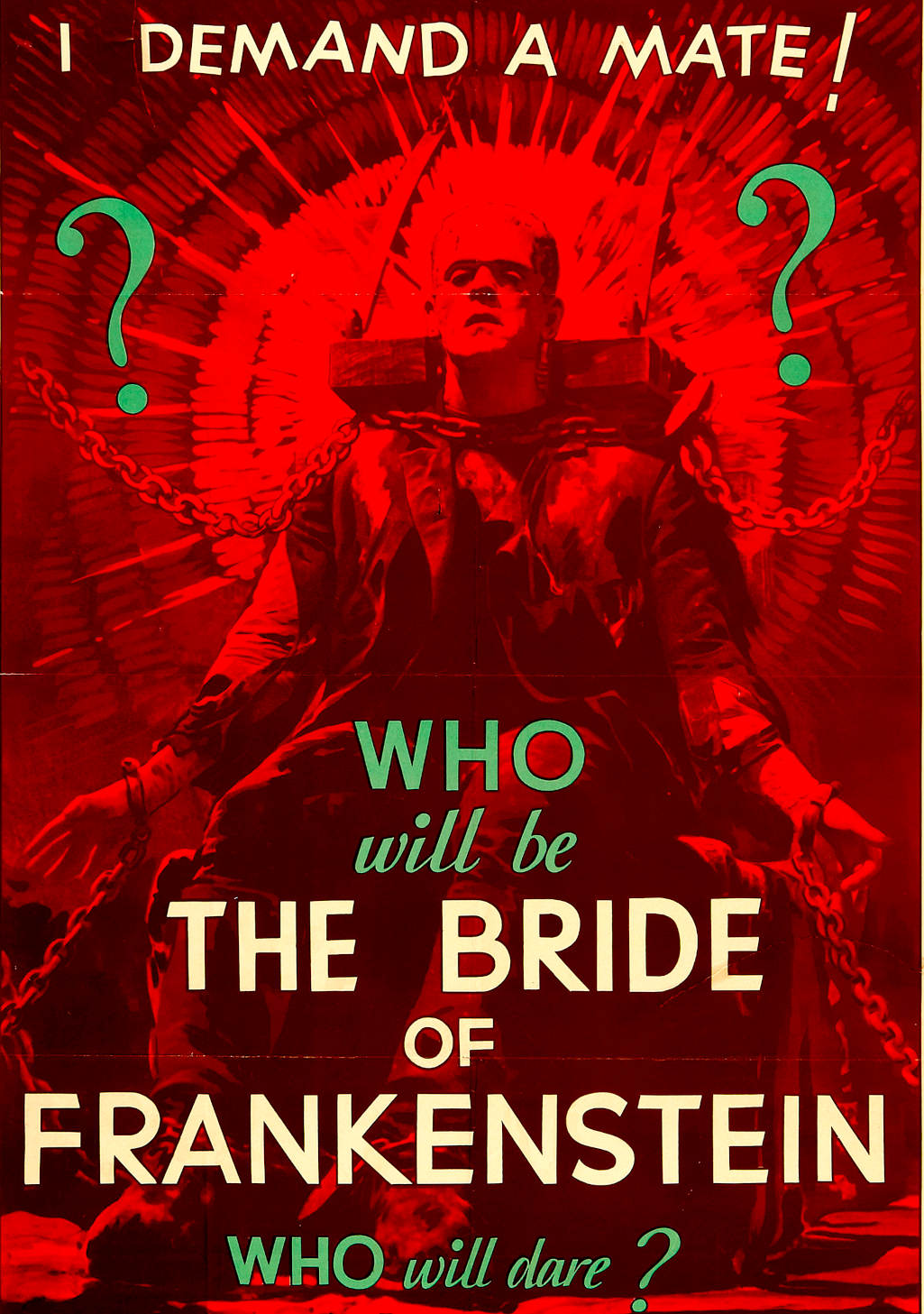
PRODUCTION
Universal considered making a sequel to Frankenstein as early as its 1931 preview screenings, following which the film's original ending was changed to allow for Henry Frankenstein's survival. James Whale initially refused to direct Bride, believing he had "squeezed the idea dry" on the first film. Kurt Neumann was originally scheduled to replace Whale but decided to film The Black Cat instead. Following the success of Whale's The Invisible Man, producer Carl Laemmle, Jr. realized that Whale was the only possible director for Bride; Whale took advantage of the situation in persuading the studio to let him make One More River. Whale believed the sequel would not top the original, so he decided instead to make it a memorable "hoot". According to a studio publicist, Whale and Universal's studio psychiatrist decided "the Monster would have the mental age of a ten-year-old boy and the emotional age of a lad of fifteen".
Screenwriter Robert Florey wrote a treatment entitled The New Adventures of Frankenstein — The Monster Lives!, but it was rejected without comment early in 1932.[8] Universal staff writer Tom Reed wrote a treatment under the title The Return of Frankenstein, a title retained until filming began. Following its acceptance in 1933, Reed wrote a full script that was submitted to the Hays office for review. The script passed its review, but Whale, who by then had been contracted to direct, complained that "it stinks to heaven". L. G. Blochman and Philip MacDonald were the next writers assigned, but Whale also found their work unsatisfactory. In 1934, Whale set John L. Balderston to work on yet another version, and it was he who returned to an incident from the novel in which the creature demands a mate. In the novel Frankenstein creates a mate, but destroys it without bringing it to life. Balderston also created the Mary Shelley prologue. After several months Whale was still not satisfied with Balderston's work and handed the project to playwright William J. Hurlbut and Edmund Pearson. The final script, combining elements of a number of these versions, was submitted for Hays office review in November 1934. Kim Newman reports that Whale planned to make Elizabeth the heart donor for the bride, but film historian Scott MacQueen states that Whale never had such an intention.
Sources report that Bela Lugosi and Claude Rains were considered, with varying degrees of seriousness, for the role of Frankenstein's mentor, Pretorius; others report that the role was created specifically for Ernest Thesiger. Because of Mae Clarke's ill health, Valerie Hobson replaced her as Henry Frankenstein's love interest, Elizabeth. Early in production, Whale decided that the same actress cast to play the Bride should also play Mary Shelley in the film's prologue, to represent how the story — and horror in general — springs from the dark side of the imagination. He considered Brigitte Helm and Phyllis Brooks before deciding on Elsa Lanchester. Lanchester, who had accompanied husband Charles Laughton to Hollywood, had met with only moderate success while Laughton had made a strong impact with several films including The Private Life of Henry VIII (for which he had won an Oscar) and Whale's own The Old Dark House. Lanchester had returned alone to London when Whale contacted her to offer her the dual role. Lanchester modeled the Bride's hissing on the hissing of swans. She gave herself a sore throat while filming the hissing sequence, which Whale shot from multiple angles.
Colin Clive and Boris Karloff reprised their roles from Frankenstein as creator and creation, respectively. Hobson recalled Clive's alcoholism had worsened since filming the original, but Whale did not recast the role because his "hysterical quality" was necessary for the film. Karloff strongly objected to the decision to allow the Monster to speak. "Speech! Stupid! My argument was that if the monster had any impact or charm, it was because he was inarticulate – this great, lumbering, inarticulate creature. The moment he spoke you might as well ... play it straight." This decision also meant that Karloff could not remove his dental plate, so now his cheeks did not have the sunken look of the original film. Whale and the studio psychiatrist selected 44 simple words for the Monster's vocabulary by looking at test papers of ten-year-olds working at the studio. Dwight Frye returned to play the doctor's assistant, Karl, having played the hunchback Fritz in the original. Frye also filmed a scene as an unnamed villager and the role of "Nephew Glutz", a man who murdered his uncle and blamed the death on the Monster. Boris Karloff is credited simply as KARLOFF, which was Universal's custom during the height of his career. Elsa Lanchester is credited for Mary Wollstonecraft Shelley, but in a nod to the earlier film, the Monster's bride is credited only as "?" just as Boris Karloff had been in the opening credits of Frankenstein.
Universal makeup artist Jack Pierce paid special attention to the Monster's appearance in this film. He altered his 1931 design to display the after-effects of the mill fire, adding scars and shortening the Monster's hair. Over the course of filming, Pierce modified the Monster's makeup to indicate that the Monster's injuries were healing as the film progressed. Pierce co-created the Bride's makeup with strong input from Whale, especially regarding the Bride's iconic hair style, based on Nefertiti. Lanchester's hair was given a Marcel wave over a wire frame to achieve the style. Lanchester disliked working with Pierce, who she said "really did feel that he made these people, like he was a god ... in the morning he'd be dressed in white as if he were in hospital to perform an operation." To play Mary Shelley, Lanchester wore a white net dress embroidered with sequins of butterflies, stars, and moons, which the actress had heard required 17 women 12 weeks to make. Lanchester said of her bride costume, "I drank as little liquid as possible. It was too much of an ordeal to go to the bathroom--all those bandages--and having to be accompanied by my dresser."
Kenneth Strickfaden created and maintained the laboratory equipment. Strickfaden recycled a number of the fancifully named machines he had created for the original Frankenstein for use in Bride, including the "Cosmic Ray Diffuser", and the "Nebularium". A lightning bolt generated by Strickfaden's equipment has become a stock scene, appearing in any number of films and television shows. The man behind the film's special photographic effects was John P. Fulton, head of the special effects department at Universal Studios at the time. Fulton and David S. Horsley created the homunculi over the course of two days by shooting the actors in full-size jars against black velvet and aligning them with the perspective of the on-set jars. The foreground film plate was rotoscoped and matted onto the rear plate. Diminutive actor Billy Barty is briefly visible from the back in the finished film as a homunculus infant in a high chair, but Whale cut the infant's reveal before the film's release.
Whale met Franz Waxman at a party and asked him to score the picture. "Nothing will be resolved in this picture except the end destruction scene. Would you write an unresolved score for it?" asked Whale. Waxman created three distinctive themes: one for the Monster; one for the Bride; and one for Pretorius. The score closes, at Whale's suggestion, with a powerful dissonant chord, intended to convey the idea that the on-screen explosion was so powerful that the theater where the film was being screened was affected by it. Constantin Bakaleinikoff conducted 22 musicians to record the score in a single nine-hour session.
Shooting began on January 2, 1935, with a projected budget of US$293,750 ($5.54 million as of 2022) – almost exactly the budget of the original – and an estimated 36-day shooting schedule. On the first day, Karloff waded in the water below the destroyed windmill wearing a rubber suit under his costume. Air got into the suit and expanded it like an "obscene water lilly". Later that day, Karloff broke his hip, necessitating a stunt double. Clive had also broken his leg. Shooting was completed on March 7, 1935. The film was ten days over schedule because Whale shut down the picture for ten days until Heggie became available to play the
Hermit. With a final cost of $397,023 ($9.38 million as of 2022), Bride was more than $100,000 ($1.89 million as of 2022) over budget. As originally filmed, Henry died fleeing the exploding castle. Whale re-shot the ending to allow for their survival, although Clive is still visible on-screen in the collapsing laboratory. Whale completed his final cut, shortening the running time from about 90 to 75 minutes and re-shooting and re-editing the ending, only days before the film's scheduled premiere date.
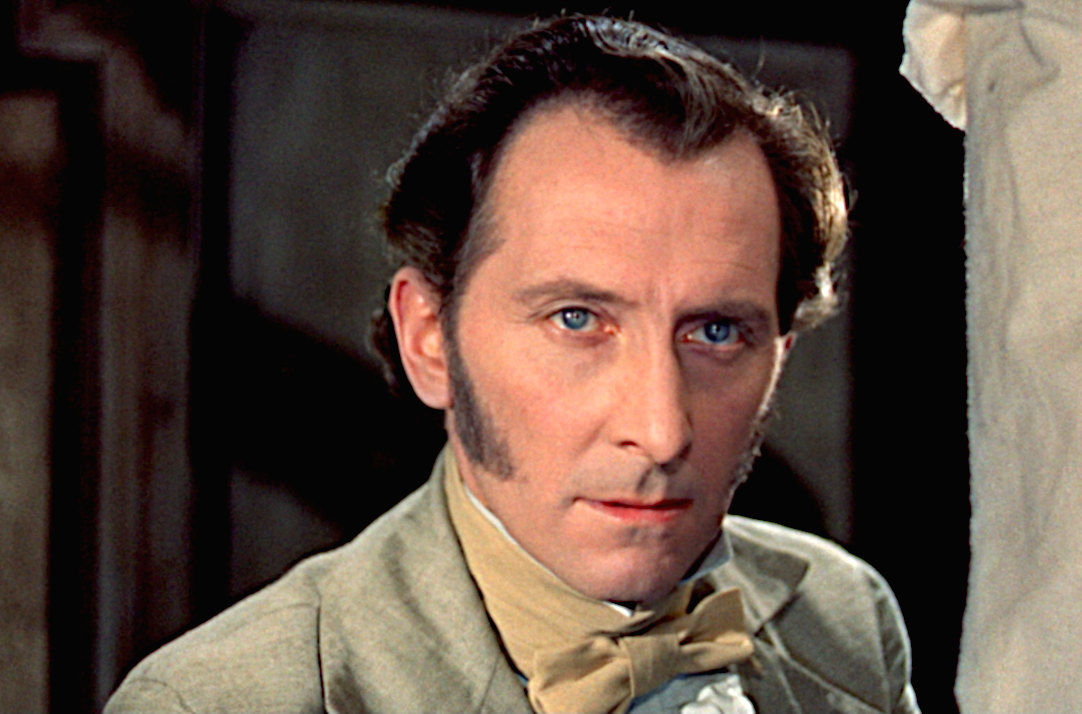
THE CURSE OF FRANKENSTEIN 1957
The Curse of Frankenstein is a 1957 British horror film by
Hammer Film Productions, loosely based on the 1818 novel
Frankenstein; or, The Modern Prometheus by Mary Shelley. It
was Hammer's first colour horror film, and the first of
their Frankenstein series. Its worldwide success led to
several sequels, and it was also followed by new versions of
Dracula (1958) and The Mummy (1959), establishing
"Hammer Horror" as a distinctive brand of Gothic
cinema.
The film was directed by Terence Fisher and stars Peter
Cushing as Victor Frankenstein and Christopher Lee as the
Creature, with Hazel Court and Robert Urquhart. Professor
Patricia MacCormack called it the "first really gory
horror film, showing blood and guts in colour".
Hammer’s
reworking of Frankenstein, adds gory colour and restores the
crazed scientist to the centre of the story bearing his name
(with a new creature for each sequel). Cushing relishes the
role of his career as the sociopathic dandy whose passion
for science overrides all moral considerations, while
Christopher Lee conveys the dire plight of the creature
through body language alone. Critics found it “depressing
and degrading”, but the film was a huge hit and spawned
six sequels, five of them starring Cushing, whose baron
became increasingly arrogant and amoral with every film.
PLOT
In 19th century Switzerland, Baron Victor Frankenstein is
awaiting execution for the murder of his maid Justine. He
tells the story of his life to a visiting priest.
At age 15, the death of Victor's mother leaves him in sole
control of the Frankenstein estate. He agrees to continue to
pay a monthly allowance to his impoverished aunt Sophia and
his young cousin Elizabeth. Soon afterwards, he engages
scientist Paul Krempe to tutor him. After two years of
intense study, Victor and Paul begin collaborating on
scientific experiments. One night, after a successful
experiment in which they bring a dead puppy back to life,
Victor suggests that they create a perfect human being from
body parts. Paul assists Victor at first but eventually
withdraws, unable to tolerate the continued scavenging of
human remains, particularly after Victor's fiancée - his
now grown-up cousin Elizabeth - comes to live with them.
Victor assembles his creation, with a robber's corpse found
on a gibbet, and both hands and eyes purchased from
charnelhouse workers. For the brain, Victor seeks out an
ageing and distinguished professor, so that the creature can
have a sharp mind and the accumulation of a lifetime of
knowledge. He invites the professor to his house in the
guise of a friendly visit, but pushes him over the stair
banister and kills him, making it look like an accident.
After the professor is buried, Victor proceeds to the vault
and removes his brain. Paul attempts to stop him, and the
brain is damaged in the ensuing scuffle. Paul also tries to
persuade Elizabeth to leave the house, as he has before, but
she refuses.
With all of the parts assembled, Victor brings the creature
to life. Unfortunately, the creature's damaged brain leaves
it violent and psychotic, without the professor's
intelligence. Victor locks up the creature, but it escapes
and kills an old blind man that it encounters in the woods.
After Paul shoots the creature in the eye, he and Victor
bury it in the woods. However, after Paul leaves town,
Victor digs up the creature and brings it back to life.
Justine, with whom Victor has been having an affair, claims
that she is pregnant by him and threatens to tell the
authorities about his strange experiments if he refuses to
marry her. He has her killed by the monster.
Paul returns to the house at Elizabeth's invitation the
evening before she and Victor are to be married. Victor
shows him the revived creature, and Paul threatens to report
him to the authorities. The monster escapes up on to the
roof where it threatens Elizabeth. Victor arrives with a gun
and accidentally shoots Elizabeth after seeing the monster
grabbing her. She falls unconscious, and without any more
bullets, Victor throws an oil lamp at it, causing it to fall
through the roof-light and into a vat of acid, destroying
all evidence that it existed.
The priest does not believe Victor's story. When Paul visits
him, Victor begs Paul to testify that it was the creature
who killed Justine, but he refuses and denies all knowledge
of the mad experiment. Paul joins Elizabeth, who is waiting
outside, and tells her there is nothing they can do for
Victor. After they leave, Victor is led away to the
guillotine.
BOX OFFICE
The film was a tremendous financial success and reportedly
grossed more than 70 times its production cost during its
original theatrical run.
In the UK, the film earned theatrical rentals of $1.9
million.
In the US the outstanding box office success was a surprise.
In its first week at the Paramount Theatre on Broadway
Variety reported,"Curse" Wham $72,000" and
noted,"it gave the Par flagship its biggest opening
week on straight-film policy in the last two years".
Variety continued to be impressed with its box office
numbers as it opened across the US. "Curse"
Terrific $30,900" in its first week in Los Angeles with
supporting feature X the Unknown. In an era when horror
films typically played for one week, Curse was often held
over for two and sometimes three weeks in major markets like
Boston.
Budget £65,000 or $270,000 - Box office $8
million 728,452 admissions

FRANKENSTEIN
CREATED WOMAN 1967
Frankenstein
Created Woman is a 1967 British Hammer horror film directed
by Terence Fisher. It stars Peter Cushing as Baron
Frankenstein and Susan Denberg as his new creation. It is
the fourth film in Hammer's Frankenstein series.
Where Hammer's previous Frankenstein films were concerned
with the physical aspects of the Baron's work, the interest
here is in the metaphysical dimensions of life, such as the
question of the soul and its relationship to the body.
PLOT
Years after witnessing his father being executed by
guillotine, Hans is working as an assistant to the failed
Doctor Baron Victor Frankenstein. Frankenstein, with the
help of Dr. Hertz, is in the process of discovering a way of
trapping the soul of a recently deceased person.
Frankenstein believes he can transfer that soul into another
recently deceased body to restore it to life.
Hans is also the lover of Christina, daughter of innkeeper
Kleve. Christina's entire left side is disfigured and partly
paralysed. Young dandies Anton, Johann and Karl frequent
Kleve's inn and cause a disturbance. Johann threatens to
have his father revoke Kleve's license if he complains. The
three insist that they be served by Christina and mock her
for her deformities. The taunting angers Hans, who fights
the three of them and cuts Anton's face with a knife.
Eventually, Kleve throws the dandies out. They return in the
night to steal wine from his inn and when Kleve catches
them, they beat him to death.
Meanwhile, Hans spends the night with Christina, and in the
morning sees her leave on the stagecoach. Returning to town,
Hans sees a crowd outside Kleve's tavern and, based on no
evidence, is immediately presumed a suspect in the murder.
Hans is arrested. He will not reveal his time with Christina
as an alibi and, known for his short temper, is tried. The
trial is a farce and Hans is convicted. Despite Frankenstein
and Hertz's defenses against the accusations, Hans is
executed by guillotine. Seeing this as an opportunity,
Frankenstein gets hold of Hans' fresh corpse and traps his
soul.
Distraught over Hans's death, Christina drowns herself in
the river. The peasants fish out her body and bring it to
Hertz to see if he can do anything. Frankenstein and Hertz
transfer Hans' soul into her body. Over months of complex
and intensive treatment, they cure her physical deformities.
The result is a physically healthy woman with no memory of
her past life. Frankenstein insists on telling her nothing
but her name and keeping her in Hertz's house. Despite
coming to her senses regarding her identity, Christina is
taken over by the spirit of the vengeful Hans.
Christina kills Anton and Karl, driven mostly by the ghostly
insistence of Hans. Frankenstein and Hertz become suspicious
of her behaviour and take her to the guillotine where Hans
and his father were executed. However, they believe she
subconsciously retains the memories of Hans' father's death
rather than of Hans himself. By the time Frankenstein
realises the truth, he finds her already murdering Johann.
Despite Frankenstein's pleas, Christina knows she now has no
one and nothing left to live for and drowns herself again.
Frankenstein, disappointed and having apparently learned a
lesson, walks away silently.
THE
BRIDE 1985
The Bride is a 1985 British-American horror film directed by Franc Roddam and written by Lloyd Fonvielle, based on Mary Shelley's novel Frankenstein. The film stars Sting as Baron Charles Frankenstein and Jennifer Beals as Eva, a woman he creates in the same fashion as his infamous monster.
The film, an international co-production between the United Kingdom and the United States, was released theatrically on August 16, 1985 by Columbia Pictures to generally negative reviews from critics. It was a commercial failure, grossing only $3.6 million.
PLOT
Charles, Baron Frankenstein, Dr. Zalhus, and Frankenstein's assistant, Paulus, attempt to create a female mate, Eva, for his creation. They succeed, creating Eva, who is physically identical to a human and lacking the deformities of the monster. As such, she is revolted by the monster and rejects him. This causes the monster to fly into a rage and destroy Frankenstein's laboratory. Frankenstein, believing the monster has died, flees with Eva back to Castle Frankenstein. There he falls in love with her and educates her with the goal of making her a perfect human mate.
The monster, having survived, wanders into the countryside where he befriends a dwarf, Rinaldo. As they learn more about one another, Rinaldo eventually gives the monster more humanity by gracing him with a name: Viktor ("he will win"). They become involved with a circus owner who eventually kills Rinaldo, causing Viktor to sink into a state of deep sorrow and rage.
Viktor decides to return to Castle Frankenstein to retrieve his mate. At this time, Eva discovers that she shares a psychic link with Viktor. She rejects the Baron as Viktor arrives at the castle to rescue her. The Baron confronts Viktor, and falls to his death when they fight. Viktor returns to Eva and when she awakens, he turns to leave. Eva asks him to stay and he introduces himself to her with his name. She tells him the meaning of his name, which pleases him. She asks if he knows who made him and he reveals that it was the Baron. Reunited, they head off to Venice to fulfill Rinaldo's dream.
MARY
SHELLEY'S FRANKENSTEIN 1994
Mary Shelley's Frankenstein is a 1994 science fiction horror film directed by Kenneth Branagh, and starring Robert De Niro, Kenneth Branagh, Tom Hulce, Helena Bonham Carter, Ian Holm, John Cleese, Richard Briers and Aidan Quinn. The film was produced on a budget of $45 million and is considered the most faithful film adaptation of Mary Shelley's 1818 novel Frankenstein; or, The Modern Prometheus, despite several differences and additions in plot from the novel. The film received mixed reviews from critics and was not as successful as Bram Stoker’s Dracula, grossing $112 million worldwide.
In 1794, Captain Walton leads a troubled expedition to reach the North Pole. While their ship is trapped in the ice of the Arctic Sea, the crew hears a frightening noise and witnesses a mysterious figure killing their sled dogs before vanishing. The crew rescues a man, Victor Frankenstein, who had fallen in the Arctic waters. When Walton tells Victor of his determination to continue the expedition, Victor replies, "Do you share my madness?" He proceeds to tell Walton and the crew his life story, presented flashback.
Victor grows up in Geneva with his adopted sister, Elizabeth Lavenza, the love of his life. Before he leaves for the University of Ingolstadt, Victor's mother dies giving birth to his brother William. Devastated by her loss, Victor vows on his mother's grave that he will find a way to conquer death. Victor and his friend Henry Clerval study under Shmael Augustus Waldman, a professor whose notes contain information on how to create life; Waldman warns Victor not to use them, lest he create an "abomination."
While performing vaccinations, Waldman is murdered by a patient, who is later hanged in the village square. Using the killer's body, a leg from a fellow student who died of cholera, and Waldman's brain, Victor builds a creature based on the professor's notes. He is so obsessed with his work that he drives Elizabeth away when she comes to take him away from Ingolstadt, which is being quarantined amid a cholera epidemic. Victor finally gives his creation life, but he is horrified by the creature's hideous appearance and tries to kill him. Frightened and confused, the creature steals Victor's coat and flees the laboratory, and is later driven away by the townspeople when he tries to steal food.
The creature finds shelter in a family's barn and stays there for months without their knowledge, gradually learning to read and speak by watching them. He attempts to earn their trust by anonymously bringing them food, and eventually converses with the elderly, blind patriarch after murdering an abusive debt collector. When the blind man's family returns, however, they are terrified of the creature and chase him away. The creature finds Victor's journal in his coat and learns of the circumstances of his creation. He burns down the farm and vows revenge on Victor for bringing him into a world that hates him.
Victor returns to Geneva to marry Elizabeth, only to find that his younger brother William has been murdered. The Frankensteins' servant Justine is blamed for the crime and hanged, but Victor knows the creature is responsible. The creature abducts Victor and demands that he make a female companion for him, promising to leave his creator in peace in return. Victor begins gathering the tools he used to create life, but when the creature insists that he use Justine's body to make the companion, a disgusted Victor breaks his promise. The creature exacts his revenge on Victor's wedding night by breaking into Elizabeth's bridal suite and killing her.
Desperate with grief, Victor races home to bring Elizabeth back to life. He stitches Elizabeth's head onto Justine's body and reanimates her as a disfigured, mindless shadow of her former self. The creature appears, demanding Elizabeth as his bride. Victor and the creature fight for Elizabeth's affections, but Elizabeth, horrified by her own reflection, commits suicide by setting herself on fire. Both Victor and the creature escape as the mansion burns down.
The story returns to the Arctic. Victor tells Walton that he has been pursuing his creation for months to kill him. Soon after relating his story, Victor dies of pneumonia. Walton discovers the creature weeping over Victor's body, having lost the only family he has ever known. The crew prepares a funeral pyre, but the ceremony is interrupted when the ice around the ship cracks. Walton invites the creature to stay with the ship, but the creature insists on remaining with the pyre. He takes the torch and burns himself alive with Victor's body. Walton, having seen the consequences of Victor's obsession, orders the ship to return home.
DEPRAVED
2019
Depraved is a 2019 American horror film written and directed by Larry Fessenden and starring David Call and Joshua Leonard. It is a modern version of Mary Shelley's Frankenstein.
Suffering from PTSD following his stint as an army medic, Henry now works feverishly in his Brooklyn laboratory to forget the death he witnessed overseas by creating life in the form of a man cobbled together from body parts. After procuring a brain from an unwitting victim, his
creation - Adam - is born. But it soon seems that giving life to Adam was the easy part; teaching him how to live in a dark and troubled world may be perilous.
This indie horror honcho, Larry Fessenden’s take on the Frankenstein story begins with an amnesiac stabbing victim waking up in a makeshift Brooklyn lab with a stitched-together body. The PTSD-afflicted ex-military medic who revived him tries to educate his creation in all things beautiful, but his partner has less elevated plans for the creature. Good characters, lo-fi psychedelia, sadness, doom.
REFERENCE
https://

CLEOPATRA
THE MUMMY - UNDER DEVELOPMENT 2022
'Cleopatra
- The Mummy' is the proposed sequel to 'Kulo-Luna.'
Kulo-Luna, the first script of the John Storm franchise (for which a draft
is available to studios and actor's agents). The John Storm
franchise is a series of
ocean awareness adventures, featuring the incredible solar
powered trimaran: Elizabeth
Swann. Cleopatra The Mummy, could be the pilot, with Kulo-Luna, or
Treasure Island the prequel or sequel. The
order of production could be to suit identified gaps in
entertainment, in any particular year. Equally, the trilogy,
could be adapted for network television.
|







